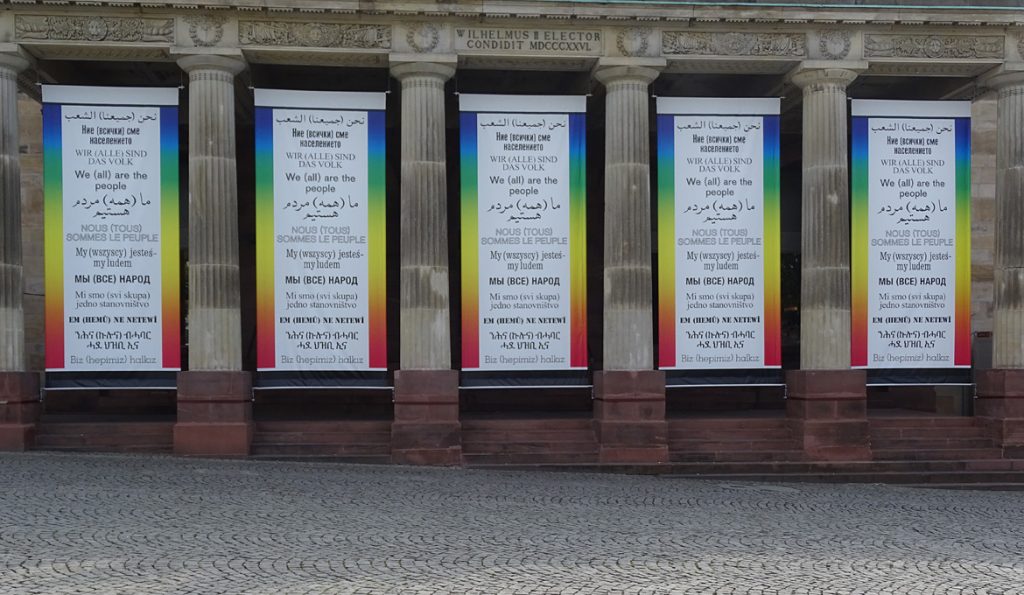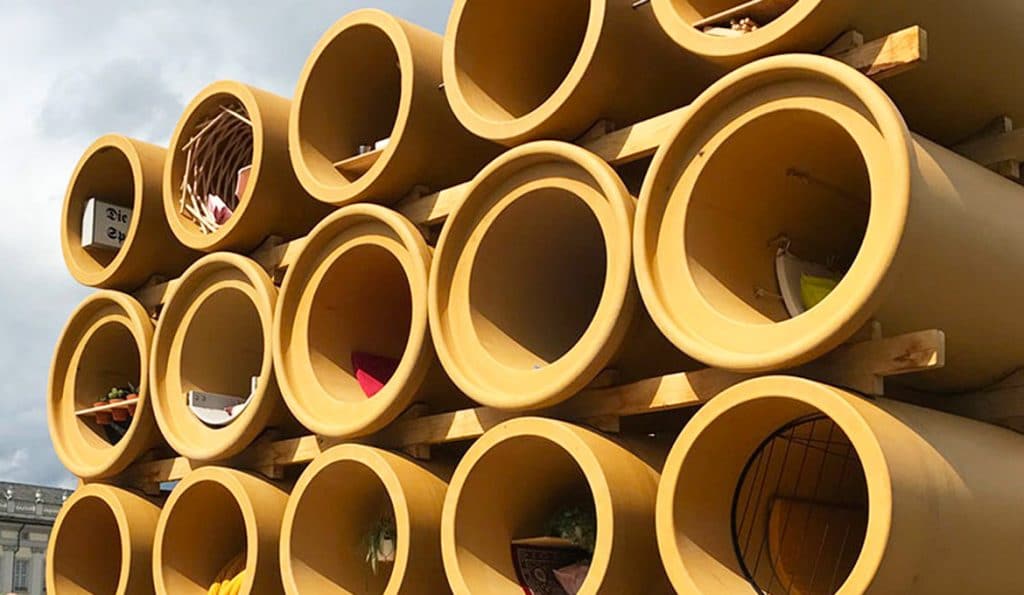Of the 100 days in which Kassel is transforming itself into 'the world museum of contemporary art' this year, as it does every five years, 20 days have already ticked away. This has certainly not happened silently. The formula that artistic director and chief curator Adam Szymczyk and his staff have unleashed on Documenta has brought a large number of enthusiasts to their feet.

For me, it is my 8ste Documenta. For forty years, in the slow rhythm of every five years, I have been visiting this 'world-unifying-museum-of-100-days'. Documenta was set up to report on the state of contemporary art. In 1987 - I was 20 - we drove to Kassel in one go. At night we slept somewhere on the frayed edge of the Karelsaue city park, near the Orangery. In a shelter tent on the banks of the Fulda. With a note behind the windscreen of the Ugly Duckling saying 'Achtung Kunstler'.

Art as a processing machine
Globalisation, breaking the Eurocentric gaze, art as a processing machine of unprocessed histories. It is the increasingly weighty stamp that curators are putting on the character of contemporary art.
I watched it all develop. I grew into this, as it were. What presented itself as a seemingly natural development of the 'super-curator', in which the art world grew and opened up to new influences. Now we have reached a point where this approach seems to be shooting itself in the foot.

Over the past 20 years, it has become a self-affirming development. At these kinds of large-scale contemporary art exhibitions like Documenta or other triennials and biennials, curators exhaust themselves in this. It seems an end in itself to report on 'contemporary art' brought together from yet another, most distant corner of our planet. Contemporary art that seems to mould itself according to the current theme set by the curator. The problem with this is that the art on show still seems to serve merely to confirm the rightness of the curator's view. The featured artist mostly a complete unknown up to that point, who has not previously contributed to the whole discourse.
The artworks so displayed are used only instrumentally. As 'the picture to the talk'. The selected artist may endorse the curator's statement. Art is not present here as an autonomous force. The work is selected as the affirmative metaphor for the condition of the world established by the curator. The curator who, as a new 'G.B.J. Hiltermann', the 'malfunction' in the world discusses. In doing so, the curator increasingly places himself in the role of an admonishing, moralising pastor.
Once surprising and hopeful
Under such circumstances, I feel compelled to refer back to, say, that 'mythical' exhibition as 'Magiciens de la Terre', Centre George Pompidou (Paris 1989) by Jean-Huber Martin. In this exhibition, art from outside known frames was shown alongside 'Western art'. Shown was where they touched in ways of seeing and working. Both surprising and hopeful about that global interconnectedness in art.

Similarly, it was with Documenta 10 in 1997, led by Catherine David that horizons were broadened. Political engagement and discourse was drawn into art. Exactly as Susanne von Falkenhausen describes it in her reflection on the Documenta. Under David, it was a delicate but well-directed balance. Political themes and art with powerful portrayals balanced each other out. Things are different now. Art with powerful, direct forms of depiction is only scarce in Documenta 14.
The demarcation is increasingly blurred
Since 1997, the pressure on the arts system to respond to political crises has only increased. The delineation of what exactly is the scope and purview of the arts has been increasingly diluted. In turn, this has obliged curators to define the task of contemporary art ever more explicitly (in political terms). As a result, the art presented in such grand overview shows is increasingly instrumental in character. In the process, its form of depiction is subordinated to its message. Thus, in many cases, it loses power.
In 2002 during Documenta 11, it was Okwui Enwezor, who brought colonialism and post-colonialism into sharp and powerful focus here. Which made the intertwining of art and politics in contemporary art even more pronounced in this curator's execution.

The Book of Books
In 2012, artistic director Carolyn Christov-Bakargiev presented her views in an 800-page catalogue. Her 'The Book of Books' was like a 'sacred script'.
In practice, the curator's modus operandi has become linked to a strictly regulated view. Thus, this cannot help but put the artist in a straitjacket. 'Comply or become obsolete' so the dogma seems to sound. Thus, an art event like Documenta no longer becomes the world unifying event where the current state of contemporary art is presented. Unfortunately, it thus becomes merely a bombastic, heavily theoretical sermon by the leading curator to his own parish.

Documenta 14
So what does this say about Adam Szymczyk's approach? First of all, I was surprised and delighted by his approach. An approach, it seemed, to make the importance of contemporary visual art catch on at the highest level. I understood the urge to want to put Documenta in the eye of the storm. To therefore Documenta alongside in Kassel, also to take place in troubled Athens.
Viewed in the actuality of four years ago, Athens was the perfect place. The place to show that the voice of art matters. Shown in strong forms. Despite the valid premise, it turns out - now that the Kassel section of Documenta 14 has also started - that it does art itself no favours. The concept of 'diagnosing the state of the world according to strictly predefined thematised rules' becomes an end in itself and it puts artists in a straitjacket and art in pigeonholes.
The anthropological artistic researcher
Theorising, through its excess, has turned into flattening. So many themes and sub-themes are addressed that the simple question arises: 'Why?' Here, artists are invariably placed in the role of 'artistic researcher'. Analogous to that of anthropological or even ethnographic researcher. The instigator of yet another 'curiosity'. It is this process that replaces the portrayal of the notion of urgency into an object -the work of art. This gives rise to the complaint that the art on display does not produce strong images. The theoretical framework overcomes....
What is the visual power of a registration form from a past gone wrong, blown up to a wall-sized projection? Does Documenta 14 thus not take the premise of Arnold Bode (initiator of Documenta) almost too literally in this sense? "To document the state of contemporary art (Where from then ever the name Documenta)". Is art really in an existential crisis then?
Dystopian escape rooms and cold-cases
In this sense, Documenta 14 shows all kinds of things under the heading of 'Art'. Especially things that in their manifestation do not appeal to us as 'Art'. Documenta 14 has therefore, in my view, degenerated into a paper tiger. It is mostly documents, recovered in archives and now shown as evidence of unexplained, unprocessed, illegitimate matters. Despite all these retro perspectives, cold-cases and historicisation, each with its importance, Documenta 14 has fallen prey to the delusion of the day.
It is thus rather a collection of judicial trials and tribulations, dystopian escape rooms and Netflix politicians. An approach that, in my view, does no real service to autonomous art. Art that is quite capable of making a powerful case for itself. Art that also holds its own without such an overly theoretical framework.

Tipping point
So why am I pleased with this Documenta? Firstly, because it is abundantly clear here that this 'curatorial straitjacket approach' does not do justice to art and artists. Including those unknown artists dragged from far away to Kassel. With that, hopefully this curatorial approach really has had its day. With that, I hope Documenta 14 marks a turning point. I am looking forward to a series of wonderfully grand exhibitions that are about powerful autonomous contemporary art. Art that makes strong statements about the world we live in, but is not framed in series of thematic boxes. Work about art's position in the world. Perhaps something like a mix of 'Magiciens de la Terre' (1989, Paris) with something like Westkunst (1981, Cologne).
Collapse of standing curatorial pratice
Do you want to witness the collapse of a standing curatorial practice? The approach that instrumentalises and thereby marginalises contemporary art? The approach that so broadens the concept of art that it becomes as thin and colourless as a homeopathic ointment? Then go to Kassel! It is the perfect opportunity to experience for yourself the foreshadowing of this paradigm shift. In my view, the bona fide reason to travel to Documenta 14.
To Kassel
There is a second reason why I am pleased with this Documenta 14, in spite of the efforts of the artistic leadership and the army of curators. Despite their efforts, I was able to observe that contemporary visual art still has that power to amaze. The power to take you out of your comfort zone to thrust. So getting through to you with undisguised eloquence. Also here (and there) in Kassel. Away from the bullshit of an overblown theoretical framework and the inevitable pigeonholing but straight into it. The pleasure this gives, why looking at art is really always satisfying.
Go watch and be surprised! Forget for a moment all the good intentions of Adam Szymczyk and his team. It's good for the catalogue. Indulge in the artworks that raise their 'voice'. As far as I am concerned, those are the lessons of Athens and Kassel, and thus of Documenta 14.
Practical information
Documenta 14 takes place this year in both Athens (still until 16 July) and Kassel (until 17 September). More information can be found at: documenta.de
All photos by Jan-Willem van Rijnberk, taken during the visit to Documenta 14.
